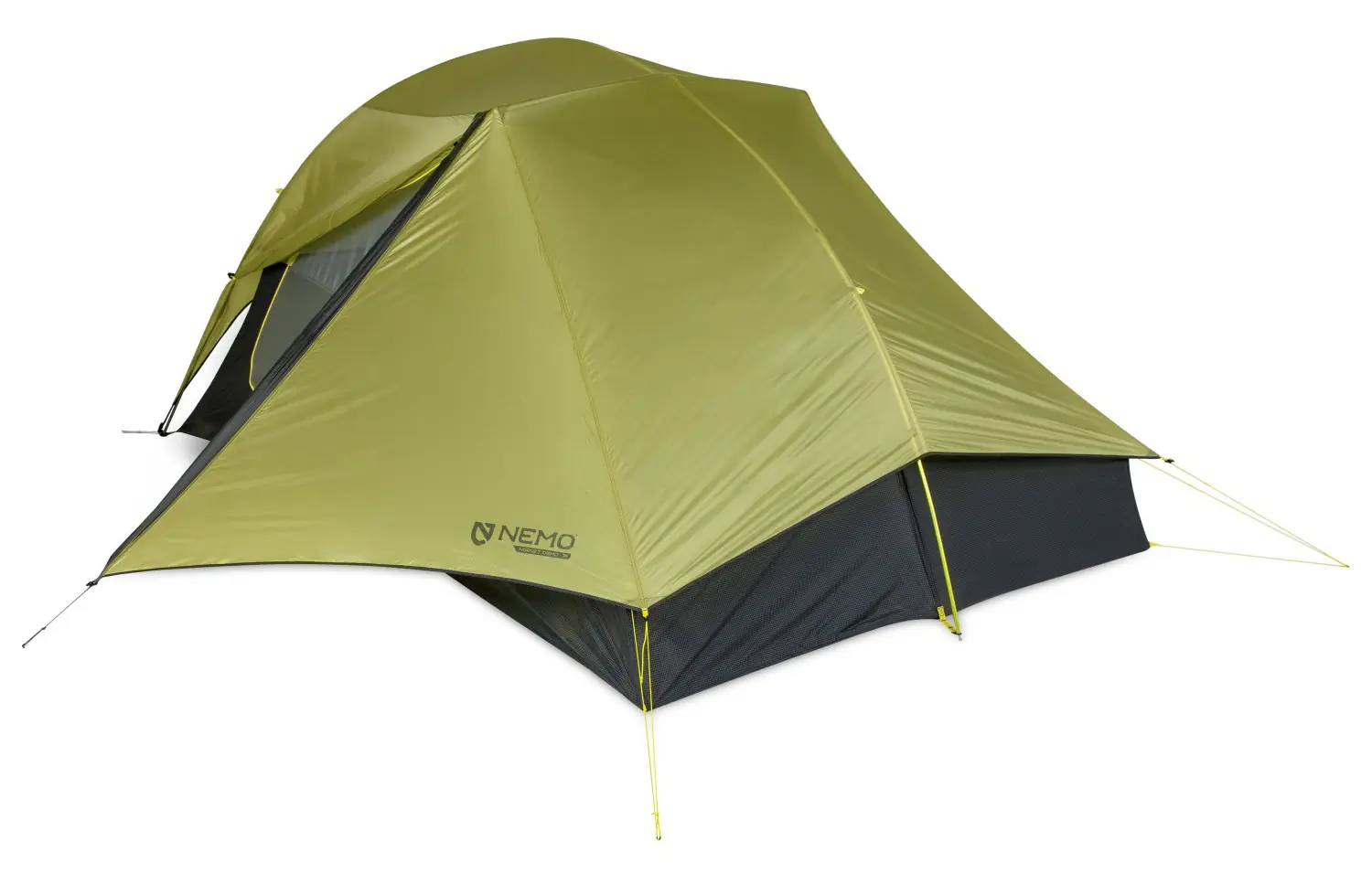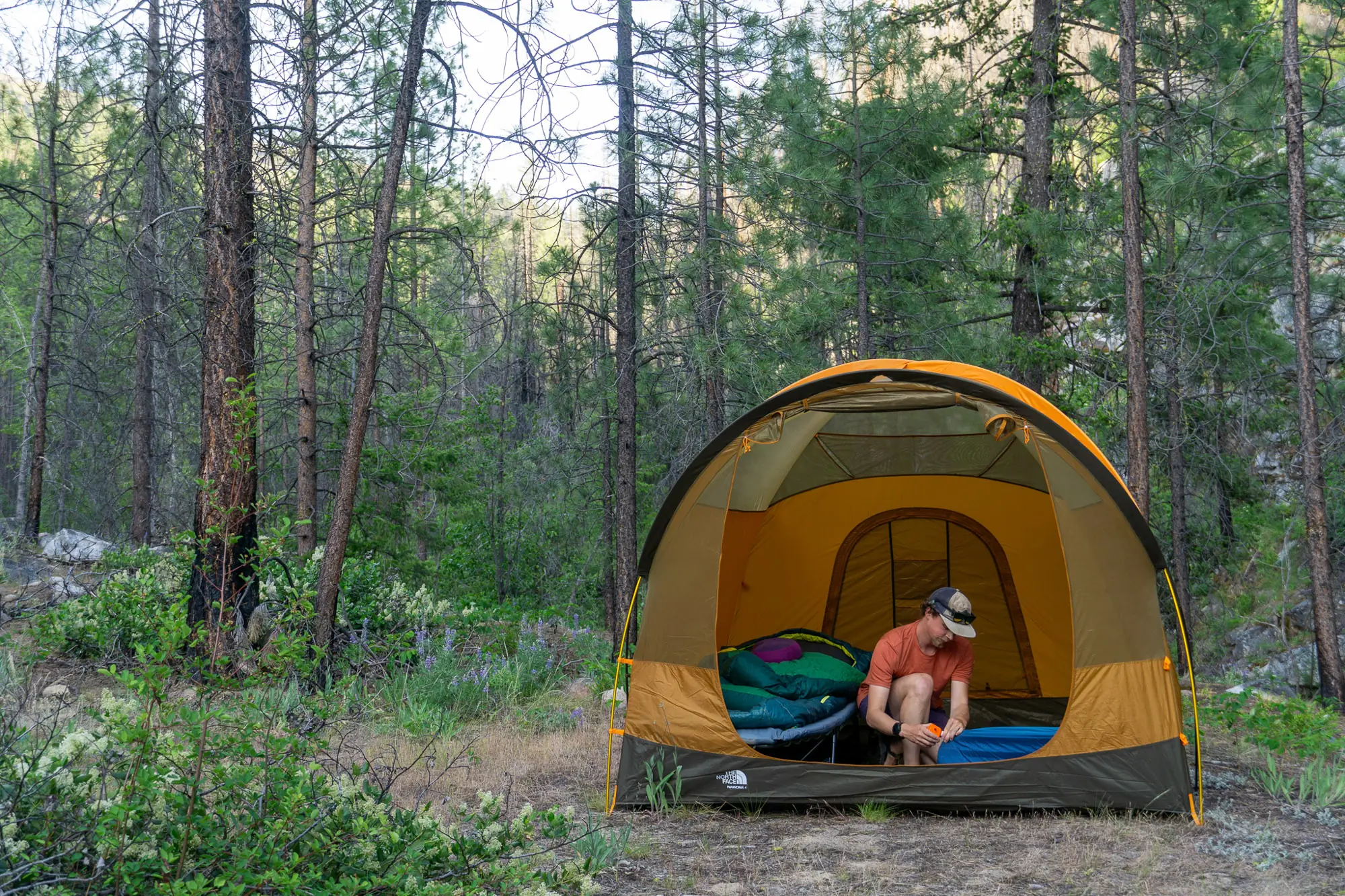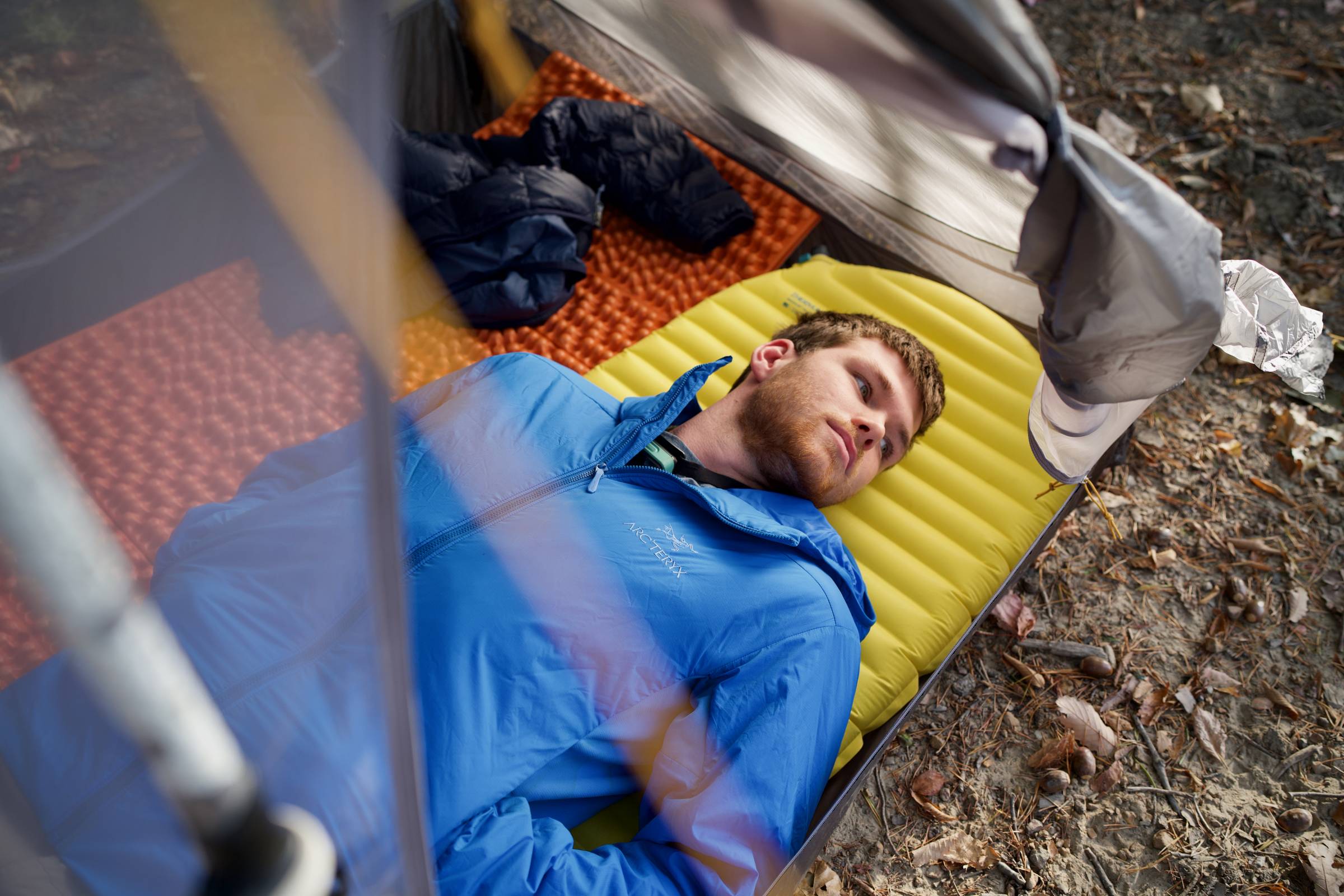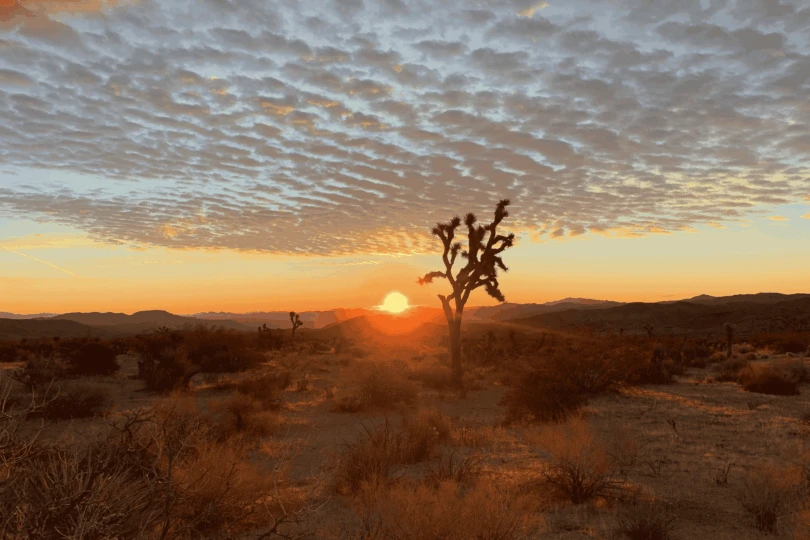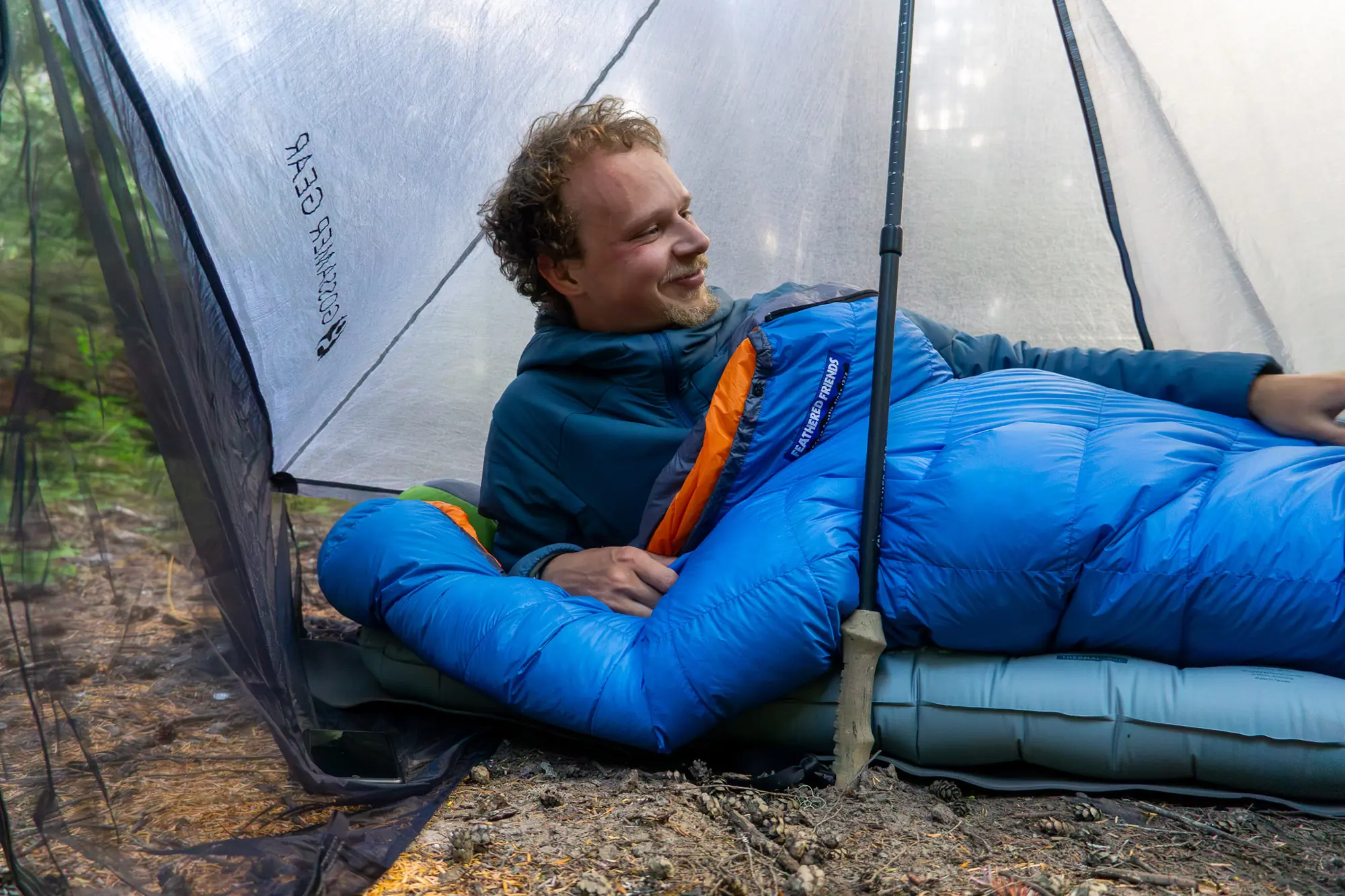My climbing partner and I leaned back against a makeshift rock windbreak, looking out over the southern Gore Range just above treeline. We nervously monitored a deep black wall of cloud creeping toward us from the south, drenching and engulfing everything in its path in darkness.
It started with a burst of heavy hail. That sent us diving into the NEMO Hornet OSMO 3P tent ($549) precariously perched on an alpine bluff. Heavy rain and tent-flattening wind bursts came in next and didn’t let up. It was an unrelenting storm with no way to escape.
While setting up the tent a few hours earlier, the weather forecast for the evening had been perfectly clear. At the time, that gave me a sense of relief because the Hornet OSMO felt excessively light for the types of storms that blast through these jagged peaks.
Yet we waited out the surprise storm underneath the thin fabric shelter. It quaked, shook, flexed, and flapped, but we emerged the next morning surprisingly dry and in good spirits. Not bad for a featherweight three-person tent. It’s the reason I keep bringing the Hornet along deep into Colorado’s backcountry.
In short: NEMO was able to trim the bulk and drop the weight with its Hornet OSMO 3P ultralight backpacking tent without making deal-breaking compromises. The semi-freestanding shelter, available in one-person, two-person, and three-person varieties, utilizes the brand’s proprietary OSMO waterproof fabric, dials in the details, withstands storms, and packs down tiny. It is, however, dependent on good stake placement, which isn’t available in all environments.
- Weight: 3 lbs., 5 oz.
- Height: 44"
- Floor space: 39.7 ft²
- Materials: 15D nylon ripstop/ No-see-um mesh (body), OSMO ripstop 1,200 mm (rainfly), OSMO ripstop 1,500 mm (floor)
- Vestibule area: 17.2 ft²
NEMO Hornet OSMO 3P Tent Review
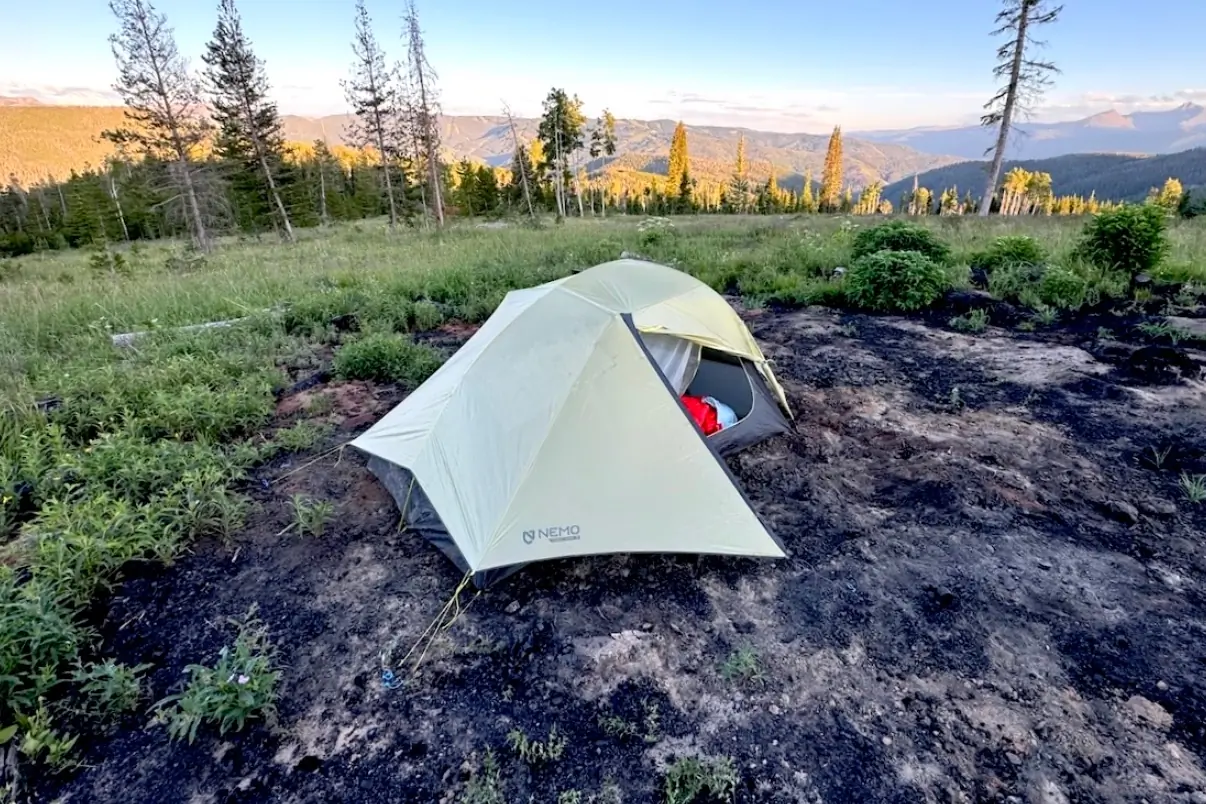
There’s hardly a better place to cut weight and bulk from a typical backpacking kit than in its shelter. Tents can be heavy, bulky, and awkward to pack. Sure, there are other options like tarps, bivy sacks, and hammocks. But a tent is tough to beat when the hail starts pounding.
The semi-freestanding Hornet OSMO 3P is a well-known ultralight competitor from a highly reputable brand. It’s one of the few products that have landed near the top of not just one but two of GearJunkie’s Buyers Guides: The Best Ultralight Tents of 2024 and The Best Backpacking Tents of 2024.
The mix of versatility, livability, and low weight had me intrigued. I stuffed the Hornet OSMO 3P into my backpack and bikepacking bags over and over again and took off into the mountains.
Weight and Size
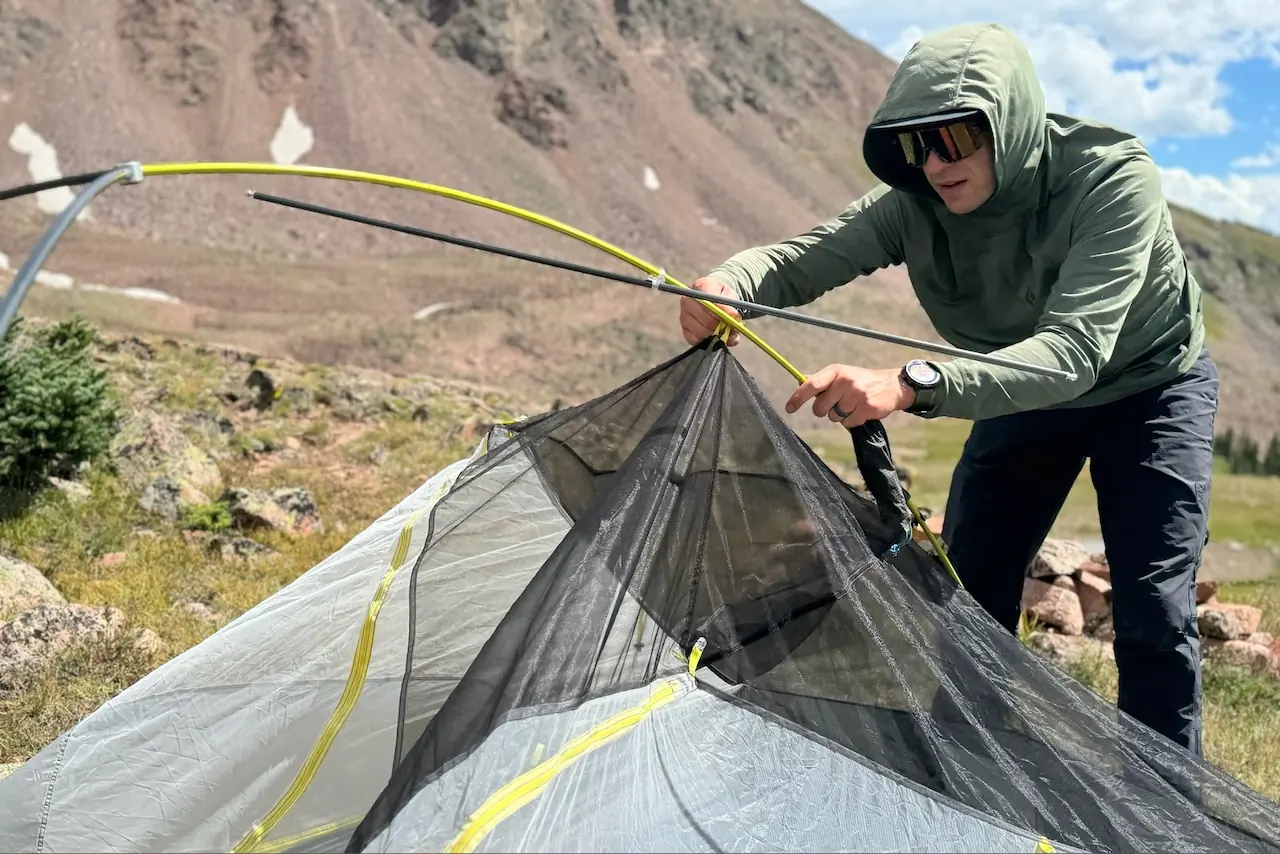



Like GearJunkie’s buyer’s guides, tents in this realm are often divided into two categories: ultralight tents and backpacking tents. Ultralight tents, like the 1.68-pound Hyperlite UltaMid 4 Pyramid Tent, often require a trekking pole to set up, whereas backpacking tents are often semi-freestanding or entirely freestanding (i.e., its tent pole structure holds them up).
The Hornet lands somewhere in the middle. It’s heavier, sturdier, and easier to set up than most ultralight tents. But it’s also lighter and less robust overall than a lot of backpacking tents.
The three-person version that I tested weighed in at 3.3 pounds (1,494 g) all in. It’s not the absolute lightest for freestanding three-person tents. It’s just a hair heavier than Big Agnes’s slightly smaller Tiger Wall UL3 Tent, for example. But it’s pretty dang good for its generous living space.
NEMO managed to shed weight from the Hornet by eliminating as many tent poles as it could. The asymmetrical 374 g pole structure attaches to the two corners at the head, and the poles connect in a “Y” overhead.
The main tent pole forms a spine that traces the length of the tent down to the foot. The corners at the foot of the tent, therefore, don’t have the support of poles. One more short pole crosses the spine at the top, adding width.
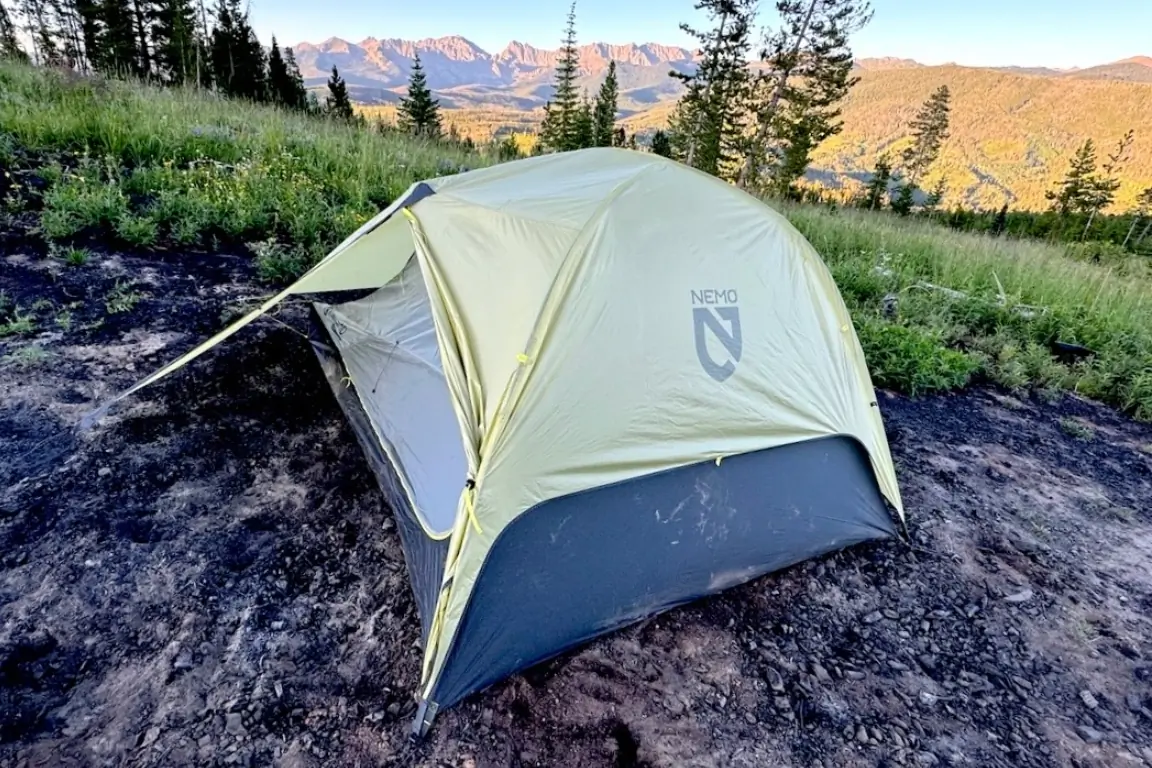



Stakes are required to pull self-equalizing strings taught to give the corners structure and secure the foot of the rainfly. That’s why it’s considered semi-freestanding. The nine included stakes weigh 170 g combined. Technically, only six are required to set it up securely, but I’d recommend eight to guyline this thing out in anything but perfect weather (more on that later).
A three-person backpacking tent often feels like a two-person tent. But the NEMO Hornet 3P had just enough room for three people who like each other. I was maybe taking up more than my fair share of space with my large 25 x 76 inch NEMO Tensor Extreme Sleeping Pad. Lengthwise, it felt plentiful at 88 inches.
Does it feel roomy with three people in there? Absolutely not, but that’s backpacking. Sleep outside if you want more room.
The Hornet was so light that I didn’t hesitate to bring it along for two sleepers. With just two people in the tent on a recent trip into Colorado’s Gore Range, there was plenty of space for our big backpacks and the rest of our gear between us. That kept the NEMO Hornet’s vestibules free for cooking while waiting out repeated storms.
Storm Protection
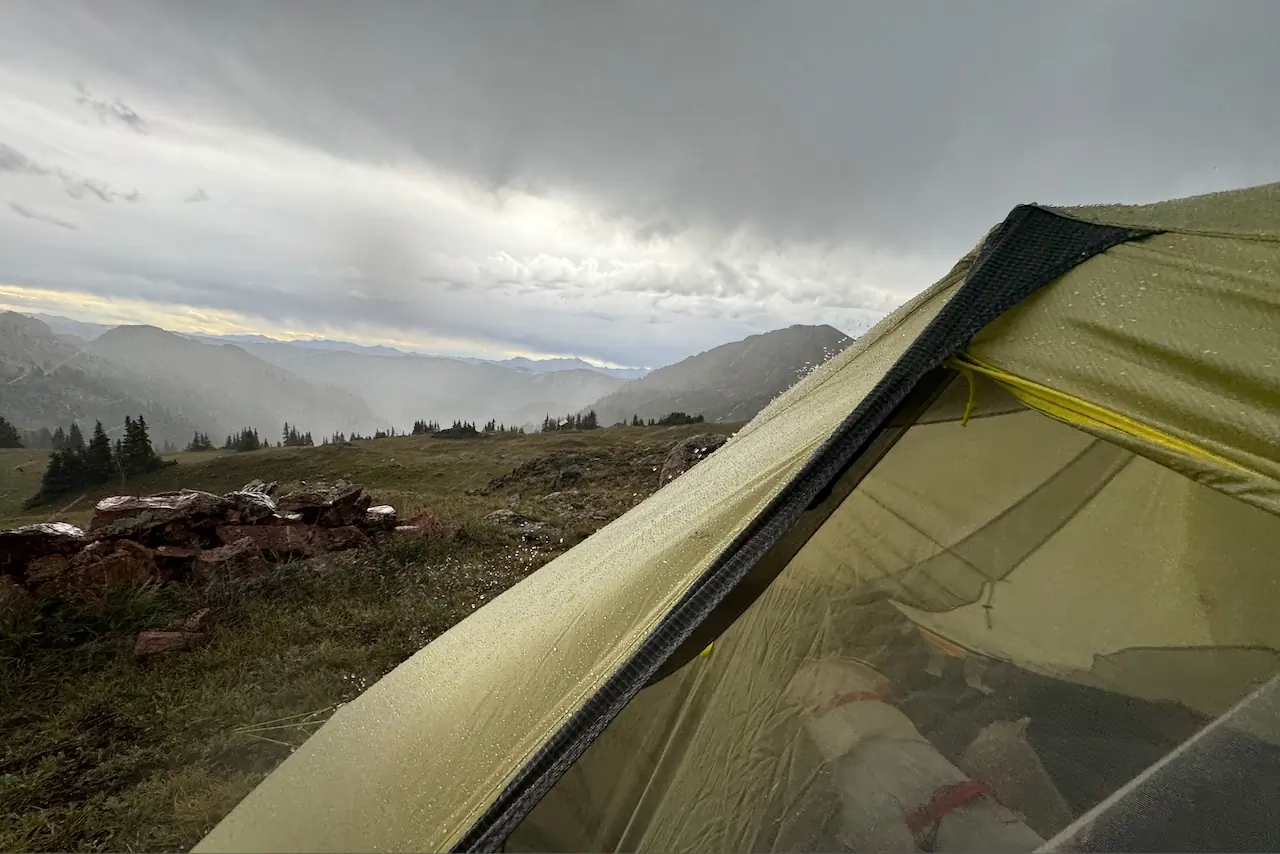



I woke up in the middle of the night during the Hornet’s first intense alpine storm, convinced that the rainfly was about to rip from the ground and whip up into the alpine. It held, but I learned a lot about how this tent reacts to really nasty storms.
My key takeaway was that the Hornet’s design is heavily dependent on stakes — more so than other backpacking tents I’ve used. As I waited it out, a few thoughts went through my head: Are those stakes really secure? Why didn’t I use two different stakes to secure the tent body and rainfly on each corner for redundancy? Why didn’t I deploy the included guylines for a little extra security?
When the storm passed, I went out and made those tweaks. The tent felt more secure through the next burst. However, even when fully staked and guylined out, the backbone pole managed to bend inward briefly during really powerful gusts, cutting the tent’s interior space by about half for brief periods. I couldn’t find a good solution other than camping in more wind-protected areas.
OSMO for the Win
At the end of the day, the tent held up and kept me dry through some seriously nasty storms above treeline. It flexed and flapped, but it never gave in. And despite heavy rains, the OSMO fabric repelled the water and wind to keep the contents and inhabitants dry. The bathtub floor did its job, too. Even without a footprint, water didn’t seep into the floor.
NEMO’s proprietary OSMO fabric is a standout feature of the Hornet. Unlike most nylon rainflies, OSMO is a blend of ripstop nylon and polyester. The polyester makes a big difference in reducing water absorption and the resulting stretch and sag.
NEMO claims OSMO has four times better water repellency and sags three times less. Testing that exact claim would require a laboratory, but I was pleasantly surprised that I didn’t need to reset the stakes each morning due to sag like I often do with other tents.
It’s important to note that the rainfly at the head of the tent does not offer full coverage, ostensibly for weight savings. I didn’t find that to be an issue during the storms. I weathered in the tent once I guylined it out to keep water from dripping onto the tent body. But I could imagine this section of the tent getting wet if it took the brunt of a wet storm.
It signals a larger reality. This is a good ultralight shelter that will protect you from storms, but it still wouldn’t be my first choice for super-rainy or windy climates where wet weather is basically a guarantee. In those scenarios, I’d probably bump up to the slightly more fortified Dagger or Dragonfly.
NEMO Hornet Details
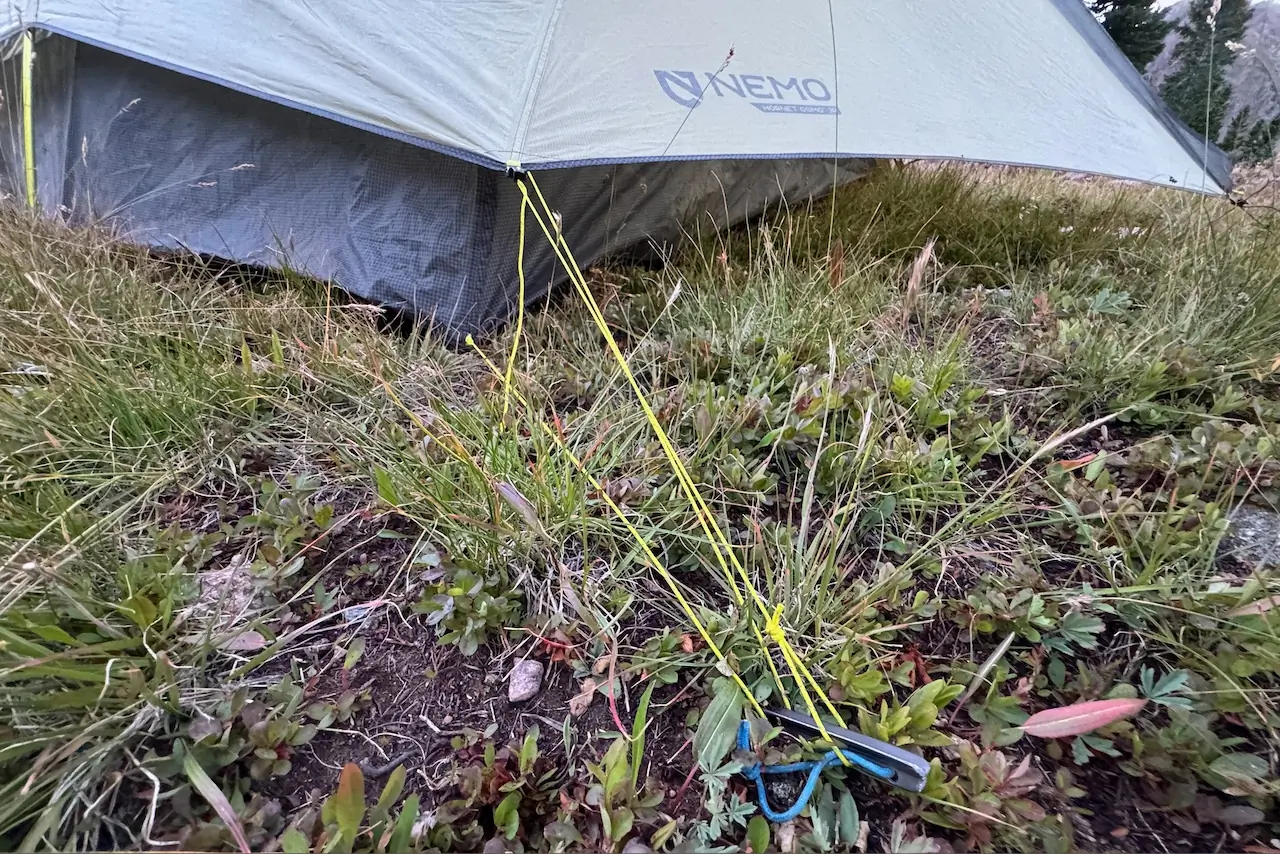



Among the characteristics of NEMO tents that I’ve grown to appreciate are the little finishes and details. There’s hardly a standard piece of hardware on this tent. All the bits and pieces feel custom and refined.
It starts at setup. The stakes have downward-facing hooks that keep the guylines from sliding off. And each corner of the rainfly gets a small camming device that can adjust the length and tautness of each staked-out guyline, which essentially replaces a trucker’s hitch (not the easiest knot to tie in the pouring rain).
It’s good news for a tent that’s so dependent on good stake placement. It adds flexibility to the stake location so you can find the best dirt and simply tighten or loosen the line through the device as needed.
Another example: There’s a tiny string attached to the side of the tent body that hooks under the vestibule. That pulls the sides of the tent outward, reducing the flap and increasing interior space. NEMO calls these “Volumizing Guy-outs.”
Packing up the Hornet went quickly. It breaks down even easier than it goes up. I definitely appreciated NEMO’s “Divvy Sack.” The designers realized that the weight of a tent is typically split between two different people.
One gets the poles, and the other gets the tent body and fly. So why would the stuff sack be long and narrow? The Divvy Sack is a stuff sack that’s shaped like it’s actually supposed to fit inside a backpack.
I also loved that the pole segments are relatively short — 13.5 inches — which makes them easier to fit into bikepacking bags like my Tailfin Aeropack.
One detail that could use a tweak? The vestibule door tiebacks. They’re oddly low, and the door tends to unravel in the wind. Pushing the tieback higher up or adding a second would solve it.
Livability
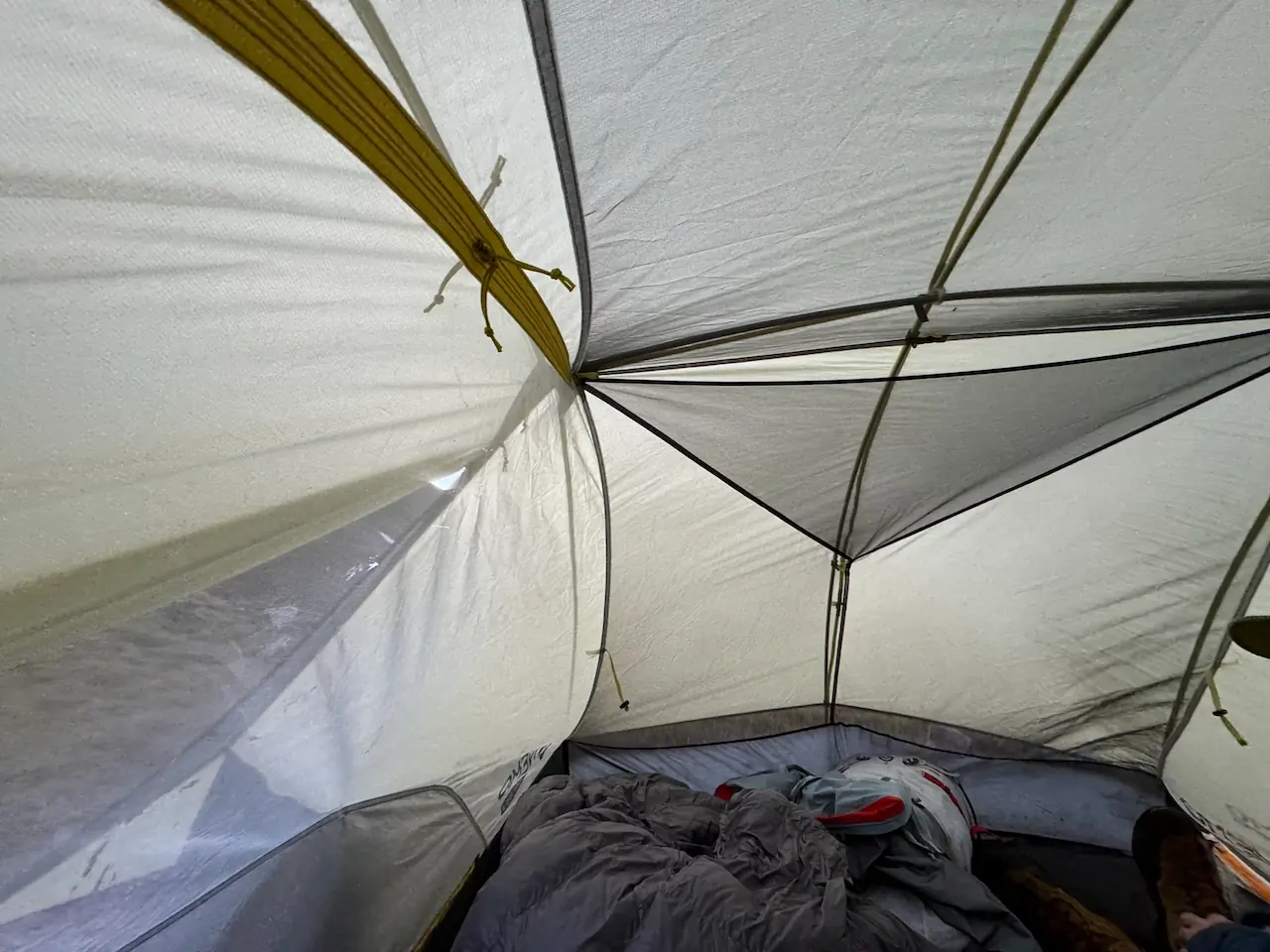



I hung out in the Hornet OSMO for a long time during the test period, and I grew to appreciate its livability. It’s a major advantage over many lighter tents.
For example, each side has a generous door, meaning there’s less crawling over each other in the night. Each side’s 8.6-square-foot vestibule felt generous, so gear storage and organization were logical. The vestibules and door openings are arranged so that it was natural to lie in the tent with the door open, the vestibule half open, and cook comfortably for wind protection.
I found the Hornet to have just enough pockets and nothing more. There’s a generous horizontal pocket at the head, one big triangular pocket in the ceiling, and a nifty light diffusing pocket up high. It was plenty to keep two campers organized. The pockets filled up fast with three inhabitants, but they felt adequate.
Durability
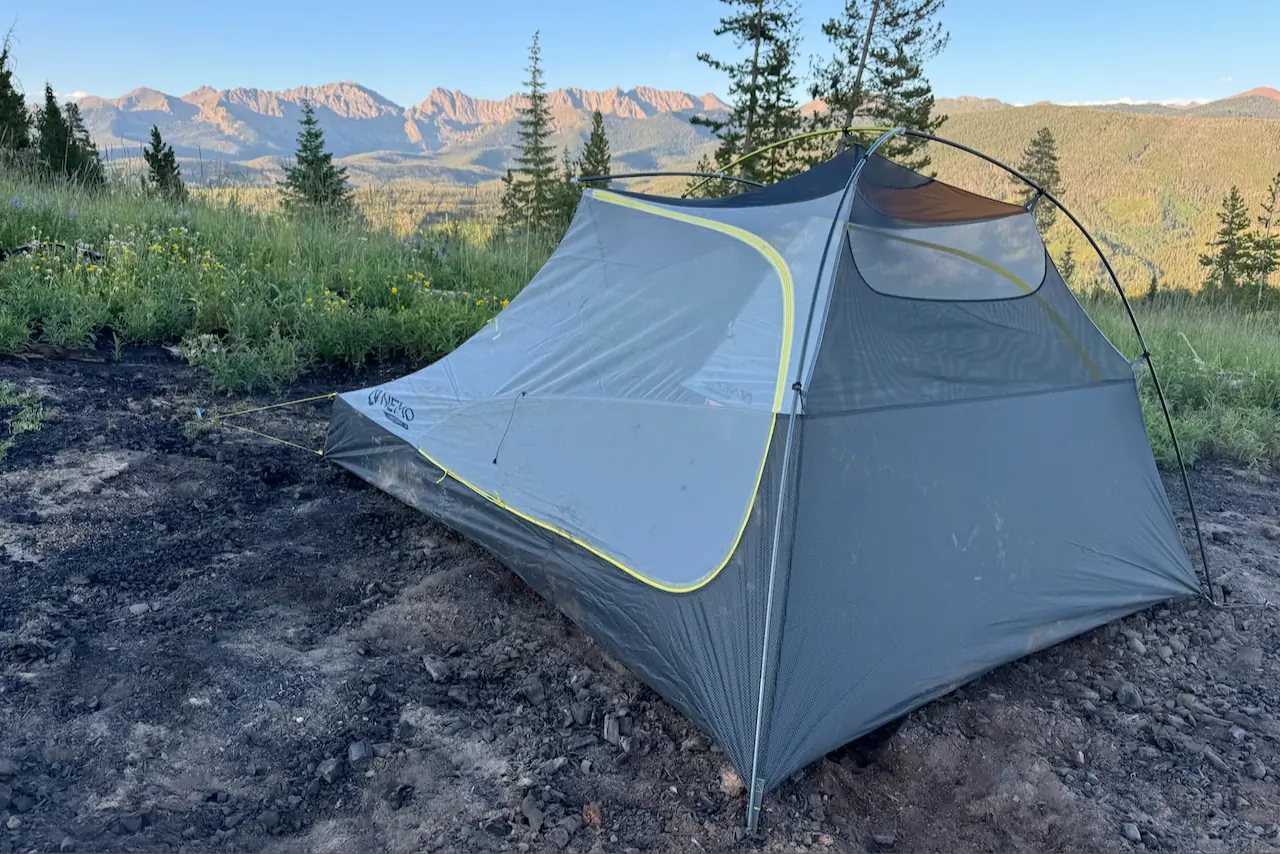



As soon as I picked up the Hornet OSMO 3P, I felt a little bit skeptical of its durability. That’s how I feel about most ultralight tents. It’s just so dang light for such a big structure. The floor fabric is incredibly thin. The OSMO rainfly is thin. The mesh is very fine. The zippers are tiny. I’ve torn clean through beefier tents than this.
But I’m happy to report that so far, despite the bashing it has taken from big hail storms and wind alike, it’s in great shape. The zippers are sliding smoothly, even the curved tracks on the doors. They have yet to get majorly jammed, though I do slide them carefully. The waterproofing remains steadfast. Overall, it’s a high-quality, well-designed tent.
Well-used tents won’t last forever, though. Especially ultralight ones like the Hornet. Thankfully, the Hornet is backed by NEMO’s lifetime warranty, but the brand also offers repair services and has an arsenal of spare parts to keep your kit out on the trail and out of the landfill.
That said, this tent is too light and relatively delicate (and expensive) to be a great car camping tent. Check out GearJunkie’s Best Camping Tents for the best options for that purpose.
NEMO Hornet Osmo 3P: Conclusion




The line between ultralight and too light is a fine one. NEMO took the Hornet OSMO up to that line without crossing it. This tent can withstand a thrashing, and after careful setup, it has kept me dry through several storms. The details are absolutely dialed. The livability and internal organization are spot on for such a light tent.
There are a few inevitable tradeoffs that come with tents this light. This tent is going to fold and bend in big storms. It’s going to flap noisily in the wind. You could get wet if it’s not guylined out correctly. But for 3.3 pounds and a packed size rivaling some ultralight two-person tents on the market, the tradeoffs make sense for me in a lot of different scenarios. I think most weight-conscious backpackers will agree.
The NEMO Hornet OSMO 3P is the tent I’m going to keep reaching for when unpredictable backpacking adventures are on tap, when weight matters, or when I need a little extra room for other sleepers or my big chocolate lab, Gus.

